Analyzing the Impact of IT on Australian Banks: A Comprehensive Report
VerifiedAdded on 2020/03/04
|10
|2119
|128
Report
AI Summary
This report provides a comprehensive literature review on the impact of Information Technology (IT) and Information and Communication Technology (ICT) on the Australian banking sector. It investigates the role of ICT in banking, focusing on customer service delivery, financial performance, and the challenges faced by banks in adopting new technologies. The report analyzes the effects of IT on customer behavior, including how consumer preferences have changed due to globalization and technological advancements. It also identifies the factors influencing customer service availability and examines strategies for reducing the challenges faced by Australian banks, such as the need for improved infrastructure and awareness of the benefits of ICT. The research questions address the extent to which IT has affected the financial performance of Australian banks and the impact of IT on employees' operational activities. The methodology involves secondary data collection from journals, books, and articles. The report concludes by summarizing the findings, emphasizing the challenges and opportunities associated with ICT adoption in the banking sector, and highlighting the need for banks to adapt to changing customer expectations and technological advancements.

Running head: IMPACT OF IT
Impact of IT
Name of the student:
Name of the university:
Author note
Table of Contents
Impact of IT
Name of the student:
Name of the university:
Author note
Table of Contents
Paraphrase This Document
Need a fresh take? Get an instant paraphrase of this document with our AI Paraphraser
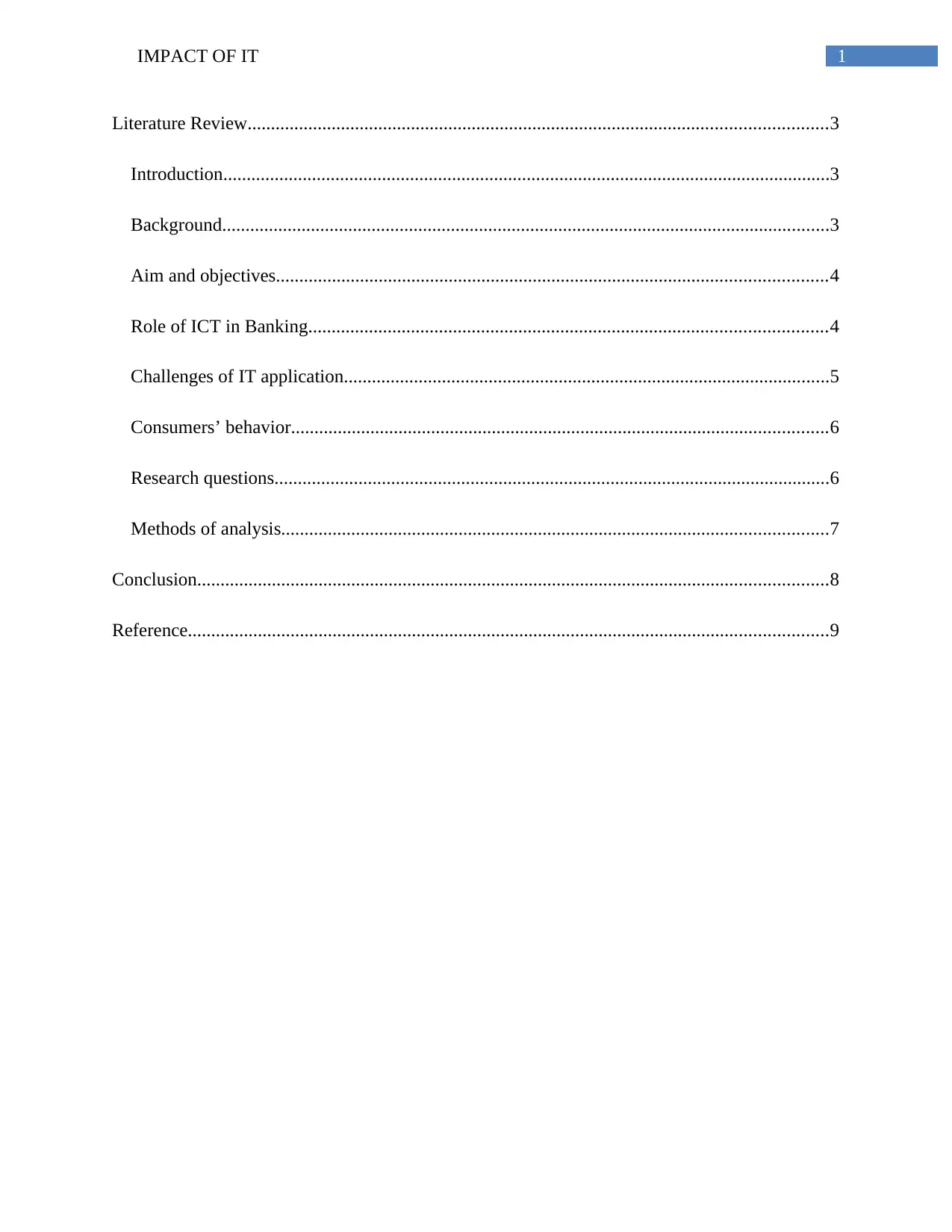
1IMPACT OF IT
Literature Review............................................................................................................................3
Introduction..................................................................................................................................3
Background..................................................................................................................................3
Aim and objectives......................................................................................................................4
Role of ICT in Banking...............................................................................................................4
Challenges of IT application........................................................................................................5
Consumers’ behavior...................................................................................................................6
Research questions.......................................................................................................................6
Methods of analysis.....................................................................................................................7
Conclusion.......................................................................................................................................8
Reference.........................................................................................................................................9
Literature Review............................................................................................................................3
Introduction..................................................................................................................................3
Background..................................................................................................................................3
Aim and objectives......................................................................................................................4
Role of ICT in Banking...............................................................................................................4
Challenges of IT application........................................................................................................5
Consumers’ behavior...................................................................................................................6
Research questions.......................................................................................................................6
Methods of analysis.....................................................................................................................7
Conclusion.......................................................................................................................................8
Reference.........................................................................................................................................9
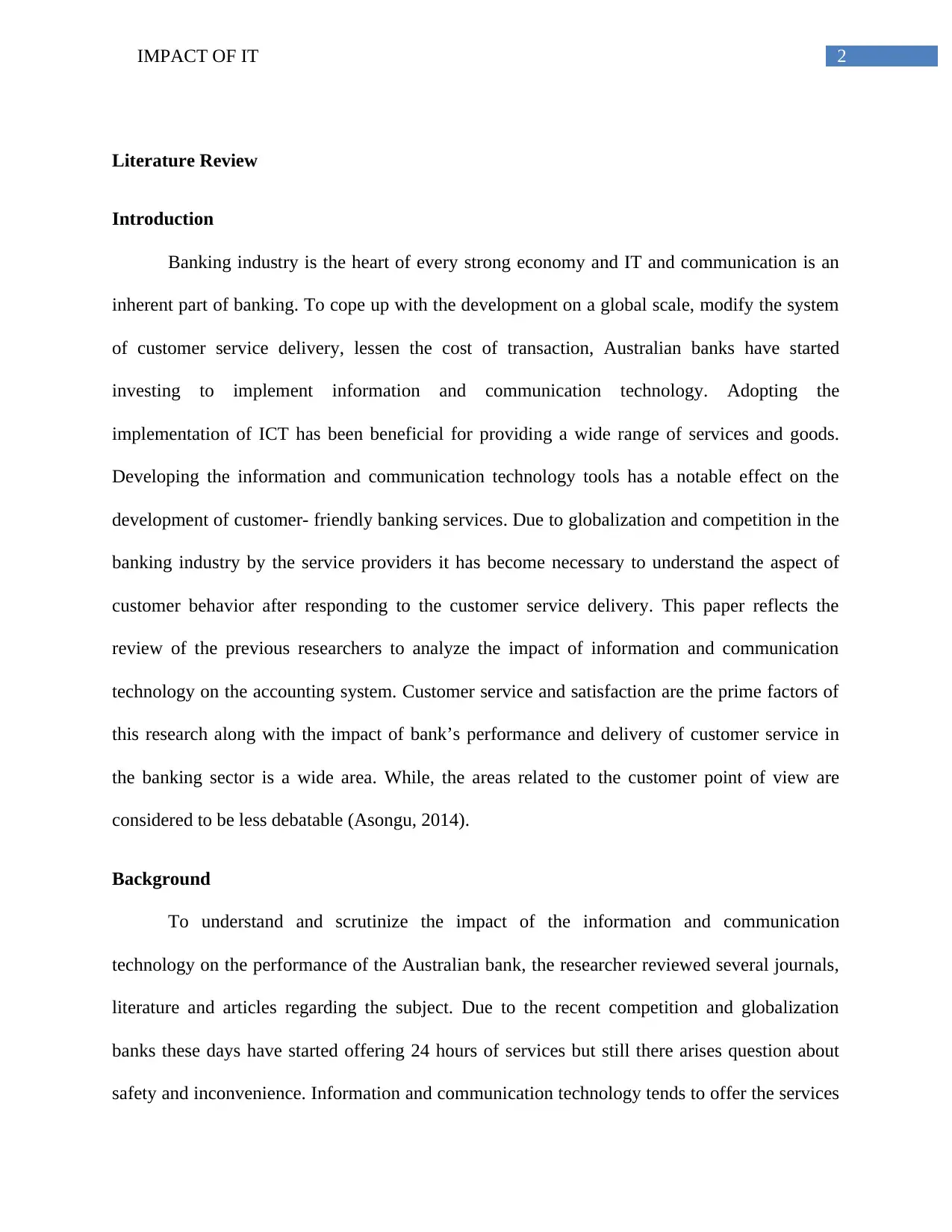
2IMPACT OF IT
Literature Review
Introduction
Banking industry is the heart of every strong economy and IT and communication is an
inherent part of banking. To cope up with the development on a global scale, modify the system
of customer service delivery, lessen the cost of transaction, Australian banks have started
investing to implement information and communication technology. Adopting the
implementation of ICT has been beneficial for providing a wide range of services and goods.
Developing the information and communication technology tools has a notable effect on the
development of customer- friendly banking services. Due to globalization and competition in the
banking industry by the service providers it has become necessary to understand the aspect of
customer behavior after responding to the customer service delivery. This paper reflects the
review of the previous researchers to analyze the impact of information and communication
technology on the accounting system. Customer service and satisfaction are the prime factors of
this research along with the impact of bank’s performance and delivery of customer service in
the banking sector is a wide area. While, the areas related to the customer point of view are
considered to be less debatable (Asongu, 2014).
Background
To understand and scrutinize the impact of the information and communication
technology on the performance of the Australian bank, the researcher reviewed several journals,
literature and articles regarding the subject. Due to the recent competition and globalization
banks these days have started offering 24 hours of services but still there arises question about
safety and inconvenience. Information and communication technology tends to offer the services
Literature Review
Introduction
Banking industry is the heart of every strong economy and IT and communication is an
inherent part of banking. To cope up with the development on a global scale, modify the system
of customer service delivery, lessen the cost of transaction, Australian banks have started
investing to implement information and communication technology. Adopting the
implementation of ICT has been beneficial for providing a wide range of services and goods.
Developing the information and communication technology tools has a notable effect on the
development of customer- friendly banking services. Due to globalization and competition in the
banking industry by the service providers it has become necessary to understand the aspect of
customer behavior after responding to the customer service delivery. This paper reflects the
review of the previous researchers to analyze the impact of information and communication
technology on the accounting system. Customer service and satisfaction are the prime factors of
this research along with the impact of bank’s performance and delivery of customer service in
the banking sector is a wide area. While, the areas related to the customer point of view are
considered to be less debatable (Asongu, 2014).
Background
To understand and scrutinize the impact of the information and communication
technology on the performance of the Australian bank, the researcher reviewed several journals,
literature and articles regarding the subject. Due to the recent competition and globalization
banks these days have started offering 24 hours of services but still there arises question about
safety and inconvenience. Information and communication technology tends to offer the services
⊘ This is a preview!⊘
Do you want full access?
Subscribe today to unlock all pages.

Trusted by 1+ million students worldwide
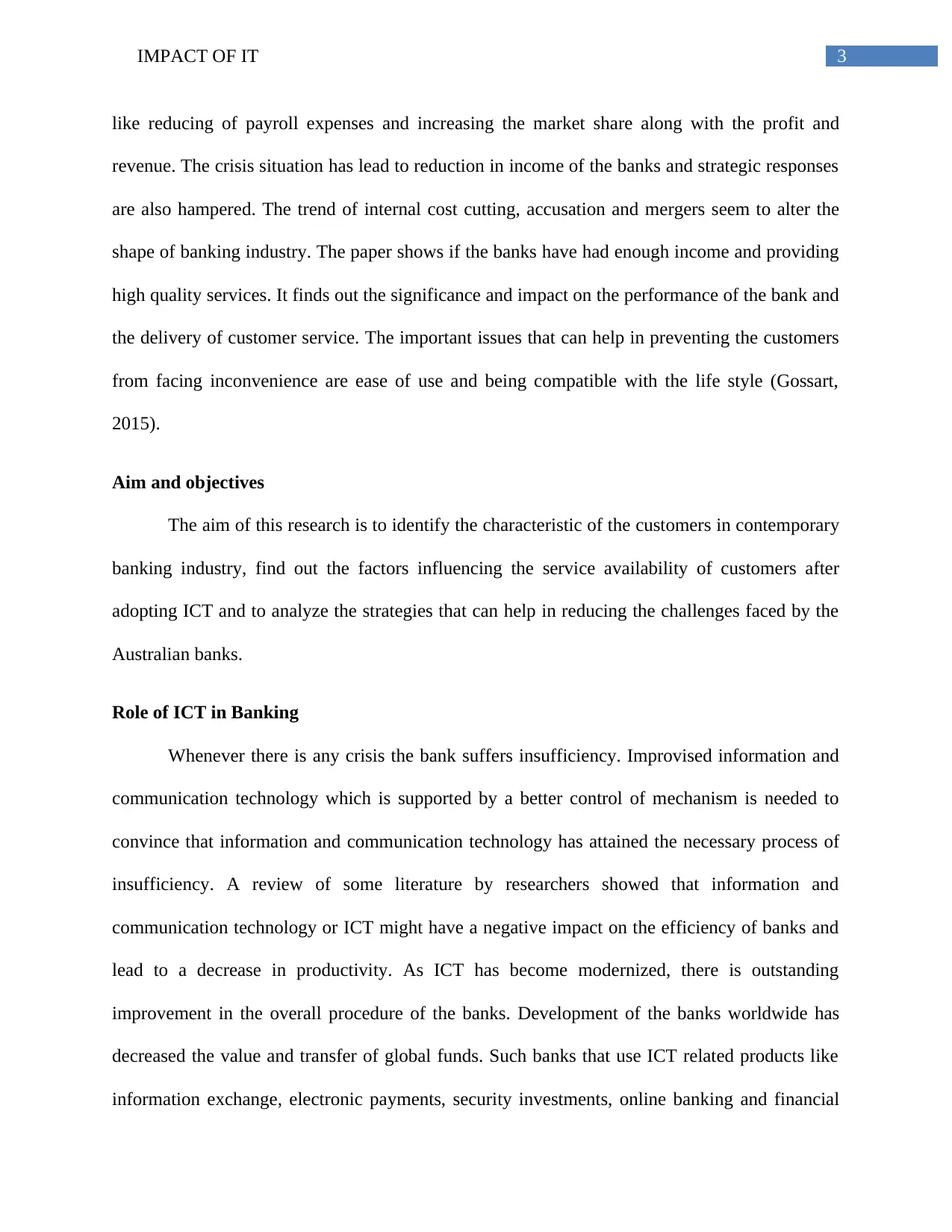
3IMPACT OF IT
like reducing of payroll expenses and increasing the market share along with the profit and
revenue. The crisis situation has lead to reduction in income of the banks and strategic responses
are also hampered. The trend of internal cost cutting, accusation and mergers seem to alter the
shape of banking industry. The paper shows if the banks have had enough income and providing
high quality services. It finds out the significance and impact on the performance of the bank and
the delivery of customer service. The important issues that can help in preventing the customers
from facing inconvenience are ease of use and being compatible with the life style (Gossart,
2015).
Aim and objectives
The aim of this research is to identify the characteristic of the customers in contemporary
banking industry, find out the factors influencing the service availability of customers after
adopting ICT and to analyze the strategies that can help in reducing the challenges faced by the
Australian banks.
Role of ICT in Banking
Whenever there is any crisis the bank suffers insufficiency. Improvised information and
communication technology which is supported by a better control of mechanism is needed to
convince that information and communication technology has attained the necessary process of
insufficiency. A review of some literature by researchers showed that information and
communication technology or ICT might have a negative impact on the efficiency of banks and
lead to a decrease in productivity. As ICT has become modernized, there is outstanding
improvement in the overall procedure of the banks. Development of the banks worldwide has
decreased the value and transfer of global funds. Such banks that use ICT related products like
information exchange, electronic payments, security investments, online banking and financial
like reducing of payroll expenses and increasing the market share along with the profit and
revenue. The crisis situation has lead to reduction in income of the banks and strategic responses
are also hampered. The trend of internal cost cutting, accusation and mergers seem to alter the
shape of banking industry. The paper shows if the banks have had enough income and providing
high quality services. It finds out the significance and impact on the performance of the bank and
the delivery of customer service. The important issues that can help in preventing the customers
from facing inconvenience are ease of use and being compatible with the life style (Gossart,
2015).
Aim and objectives
The aim of this research is to identify the characteristic of the customers in contemporary
banking industry, find out the factors influencing the service availability of customers after
adopting ICT and to analyze the strategies that can help in reducing the challenges faced by the
Australian banks.
Role of ICT in Banking
Whenever there is any crisis the bank suffers insufficiency. Improvised information and
communication technology which is supported by a better control of mechanism is needed to
convince that information and communication technology has attained the necessary process of
insufficiency. A review of some literature by researchers showed that information and
communication technology or ICT might have a negative impact on the efficiency of banks and
lead to a decrease in productivity. As ICT has become modernized, there is outstanding
improvement in the overall procedure of the banks. Development of the banks worldwide has
decreased the value and transfer of global funds. Such banks that use ICT related products like
information exchange, electronic payments, security investments, online banking and financial
Paraphrase This Document
Need a fresh take? Get an instant paraphrase of this document with our AI Paraphraser
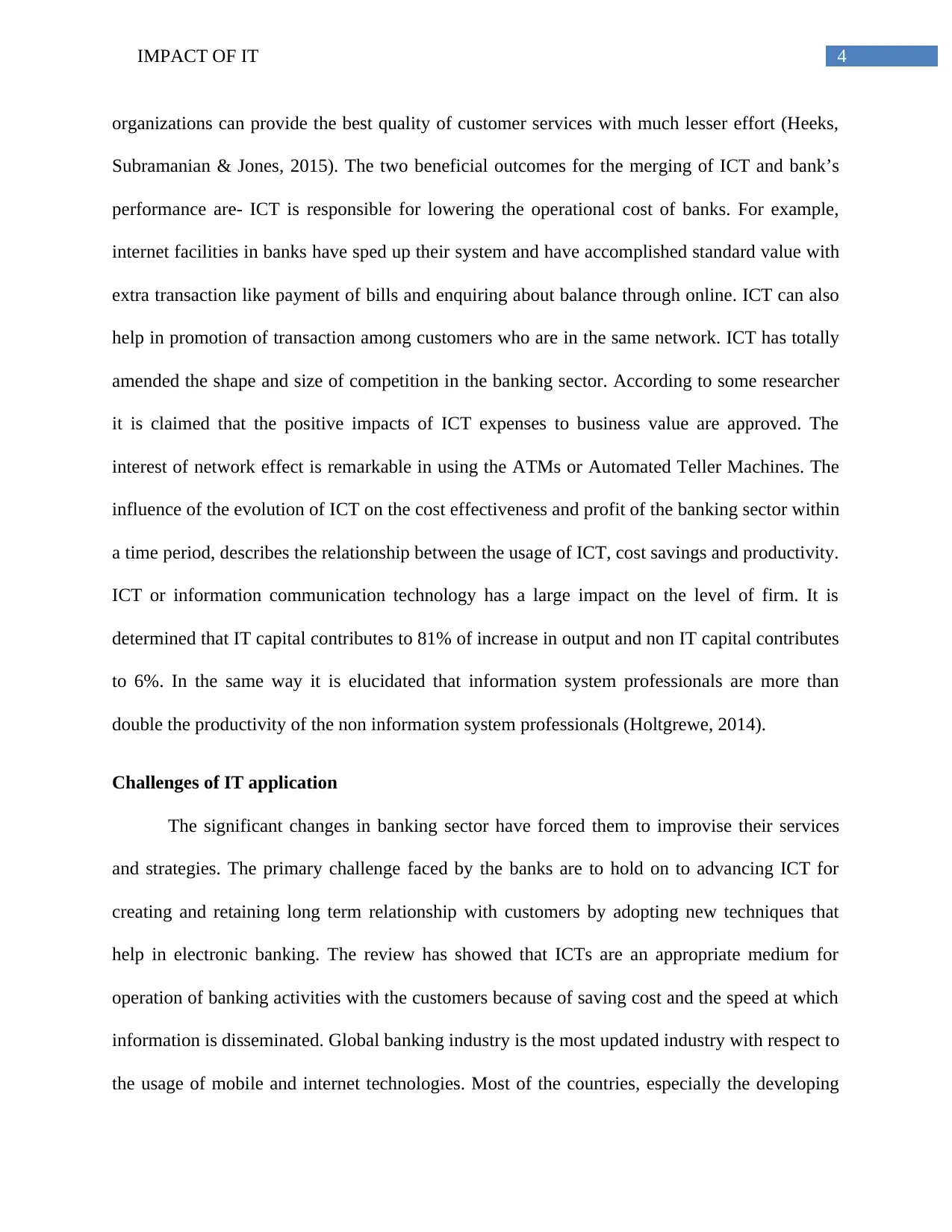
4IMPACT OF IT
organizations can provide the best quality of customer services with much lesser effort (Heeks,
Subramanian & Jones, 2015). The two beneficial outcomes for the merging of ICT and bank’s
performance are- ICT is responsible for lowering the operational cost of banks. For example,
internet facilities in banks have sped up their system and have accomplished standard value with
extra transaction like payment of bills and enquiring about balance through online. ICT can also
help in promotion of transaction among customers who are in the same network. ICT has totally
amended the shape and size of competition in the banking sector. According to some researcher
it is claimed that the positive impacts of ICT expenses to business value are approved. The
interest of network effect is remarkable in using the ATMs or Automated Teller Machines. The
influence of the evolution of ICT on the cost effectiveness and profit of the banking sector within
a time period, describes the relationship between the usage of ICT, cost savings and productivity.
ICT or information communication technology has a large impact on the level of firm. It is
determined that IT capital contributes to 81% of increase in output and non IT capital contributes
to 6%. In the same way it is elucidated that information system professionals are more than
double the productivity of the non information system professionals (Holtgrewe, 2014).
Challenges of IT application
The significant changes in banking sector have forced them to improvise their services
and strategies. The primary challenge faced by the banks are to hold on to advancing ICT for
creating and retaining long term relationship with customers by adopting new techniques that
help in electronic banking. The review has showed that ICTs are an appropriate medium for
operation of banking activities with the customers because of saving cost and the speed at which
information is disseminated. Global banking industry is the most updated industry with respect to
the usage of mobile and internet technologies. Most of the countries, especially the developing
organizations can provide the best quality of customer services with much lesser effort (Heeks,
Subramanian & Jones, 2015). The two beneficial outcomes for the merging of ICT and bank’s
performance are- ICT is responsible for lowering the operational cost of banks. For example,
internet facilities in banks have sped up their system and have accomplished standard value with
extra transaction like payment of bills and enquiring about balance through online. ICT can also
help in promotion of transaction among customers who are in the same network. ICT has totally
amended the shape and size of competition in the banking sector. According to some researcher
it is claimed that the positive impacts of ICT expenses to business value are approved. The
interest of network effect is remarkable in using the ATMs or Automated Teller Machines. The
influence of the evolution of ICT on the cost effectiveness and profit of the banking sector within
a time period, describes the relationship between the usage of ICT, cost savings and productivity.
ICT or information communication technology has a large impact on the level of firm. It is
determined that IT capital contributes to 81% of increase in output and non IT capital contributes
to 6%. In the same way it is elucidated that information system professionals are more than
double the productivity of the non information system professionals (Holtgrewe, 2014).
Challenges of IT application
The significant changes in banking sector have forced them to improvise their services
and strategies. The primary challenge faced by the banks are to hold on to advancing ICT for
creating and retaining long term relationship with customers by adopting new techniques that
help in electronic banking. The review has showed that ICTs are an appropriate medium for
operation of banking activities with the customers because of saving cost and the speed at which
information is disseminated. Global banking industry is the most updated industry with respect to
the usage of mobile and internet technologies. Most of the countries, especially the developing
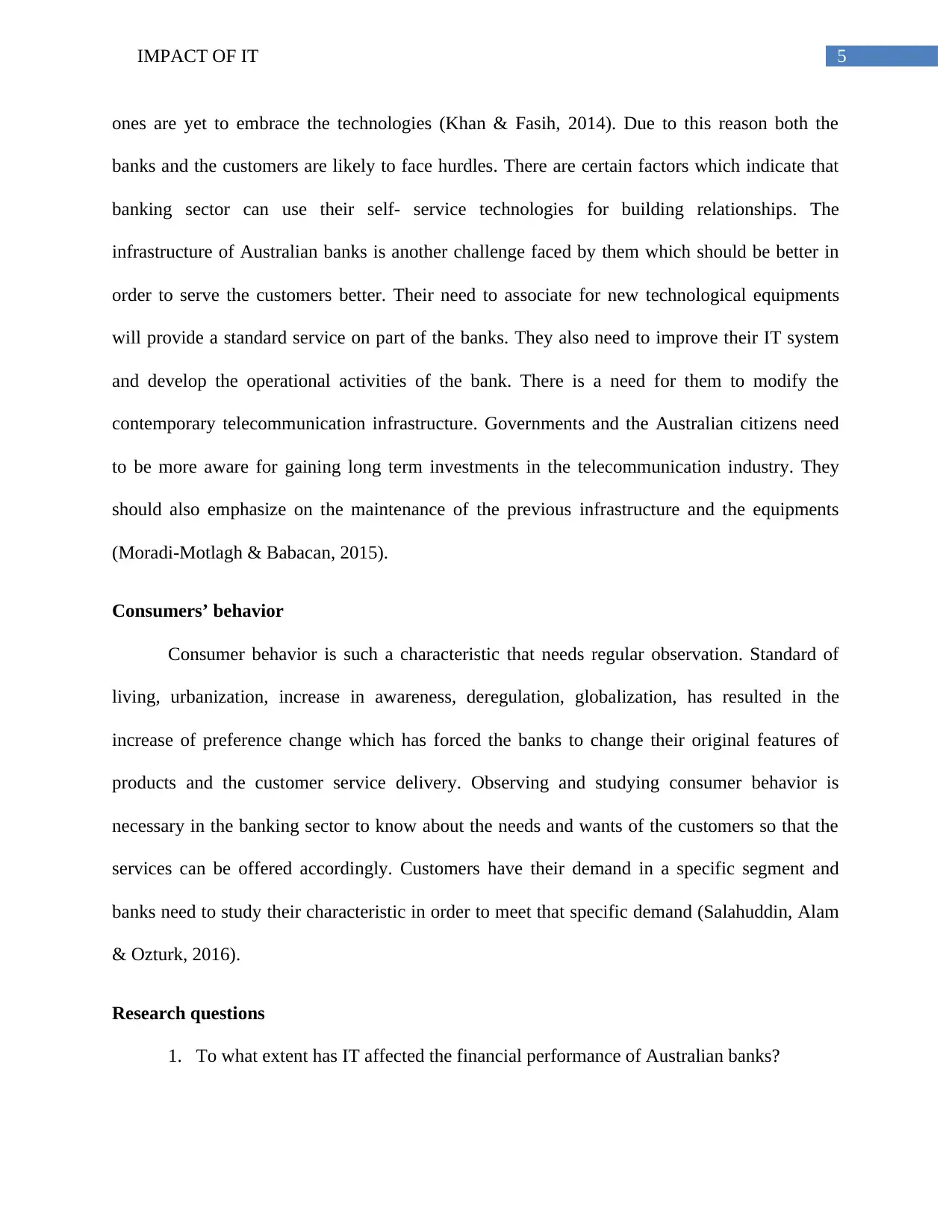
5IMPACT OF IT
ones are yet to embrace the technologies (Khan & Fasih, 2014). Due to this reason both the
banks and the customers are likely to face hurdles. There are certain factors which indicate that
banking sector can use their self- service technologies for building relationships. The
infrastructure of Australian banks is another challenge faced by them which should be better in
order to serve the customers better. Their need to associate for new technological equipments
will provide a standard service on part of the banks. They also need to improve their IT system
and develop the operational activities of the bank. There is a need for them to modify the
contemporary telecommunication infrastructure. Governments and the Australian citizens need
to be more aware for gaining long term investments in the telecommunication industry. They
should also emphasize on the maintenance of the previous infrastructure and the equipments
(Moradi-Motlagh & Babacan, 2015).
Consumers’ behavior
Consumer behavior is such a characteristic that needs regular observation. Standard of
living, urbanization, increase in awareness, deregulation, globalization, has resulted in the
increase of preference change which has forced the banks to change their original features of
products and the customer service delivery. Observing and studying consumer behavior is
necessary in the banking sector to know about the needs and wants of the customers so that the
services can be offered accordingly. Customers have their demand in a specific segment and
banks need to study their characteristic in order to meet that specific demand (Salahuddin, Alam
& Ozturk, 2016).
Research questions
1. To what extent has IT affected the financial performance of Australian banks?
ones are yet to embrace the technologies (Khan & Fasih, 2014). Due to this reason both the
banks and the customers are likely to face hurdles. There are certain factors which indicate that
banking sector can use their self- service technologies for building relationships. The
infrastructure of Australian banks is another challenge faced by them which should be better in
order to serve the customers better. Their need to associate for new technological equipments
will provide a standard service on part of the banks. They also need to improve their IT system
and develop the operational activities of the bank. There is a need for them to modify the
contemporary telecommunication infrastructure. Governments and the Australian citizens need
to be more aware for gaining long term investments in the telecommunication industry. They
should also emphasize on the maintenance of the previous infrastructure and the equipments
(Moradi-Motlagh & Babacan, 2015).
Consumers’ behavior
Consumer behavior is such a characteristic that needs regular observation. Standard of
living, urbanization, increase in awareness, deregulation, globalization, has resulted in the
increase of preference change which has forced the banks to change their original features of
products and the customer service delivery. Observing and studying consumer behavior is
necessary in the banking sector to know about the needs and wants of the customers so that the
services can be offered accordingly. Customers have their demand in a specific segment and
banks need to study their characteristic in order to meet that specific demand (Salahuddin, Alam
& Ozturk, 2016).
Research questions
1. To what extent has IT affected the financial performance of Australian banks?
⊘ This is a preview!⊘
Do you want full access?
Subscribe today to unlock all pages.

Trusted by 1+ million students worldwide

6IMPACT OF IT
2. To what extent the use of IT has helped the employees of Australian banks in their
operational activities?
Methods of analysis
The research could be done with a proper plan and methodology by collecting secondary
data. It refers to the data collected from the journals, books or articles of the previous researches.
For the successful completion of the research both primary and secondary data needs to be
collected. But in this research only secondary data needs to be collected which will the
researcher to go through the articles, books, journal that has already been published (Sassi &
Goaied, 2013).
Activities Week 1 Week 2 Week 3 Week 4
Selection of topic
Literature review
Methodology
Secondary data
collection
Interpretation
and analysis
Recommendation
Conclusion
Final submission
Table 1: Gantt chart
2. To what extent the use of IT has helped the employees of Australian banks in their
operational activities?
Methods of analysis
The research could be done with a proper plan and methodology by collecting secondary
data. It refers to the data collected from the journals, books or articles of the previous researches.
For the successful completion of the research both primary and secondary data needs to be
collected. But in this research only secondary data needs to be collected which will the
researcher to go through the articles, books, journal that has already been published (Sassi &
Goaied, 2013).
Activities Week 1 Week 2 Week 3 Week 4
Selection of topic
Literature review
Methodology
Secondary data
collection
Interpretation
and analysis
Recommendation
Conclusion
Final submission
Table 1: Gantt chart
Paraphrase This Document
Need a fresh take? Get an instant paraphrase of this document with our AI Paraphraser

7IMPACT OF IT
Source: As created by the author
Conclusion
Banking sector is the main platform on which every economy stands. There are various
challenges like competition, deregulation, globalization, and an increasingly high cost for
installation of ICT and their maintenance. Utilizing of ICT can help in reducing the cost but the
impact on the profitability is indecisive due to the possible outcome of ICT. The feasible result
arises because of the consistency in an increasing demand for skilled labor, high expectation
from the customers’ end to meet the service delivery, truthfulness of the information system and
competence in the financial services. This assignment has focused on some reviews from the
literature where the authors did not find ICT, for delivering customer service and profitable for
bank’s financial performance. Moreover, there are studies that state that as a result of the risk of
security, lack of awareness, lack of convenience or comfort or age factor or may be some other
reasons are responsible for rejection by the customers. In spite of these factors, banks sometimes
are unable to provide high quality customer services due to which customers who were ready to
adopt the new system moved back. Banks sometimes failed to build up the required electronic
system for customers which made them shift away from the new innovation.
Source: As created by the author
Conclusion
Banking sector is the main platform on which every economy stands. There are various
challenges like competition, deregulation, globalization, and an increasingly high cost for
installation of ICT and their maintenance. Utilizing of ICT can help in reducing the cost but the
impact on the profitability is indecisive due to the possible outcome of ICT. The feasible result
arises because of the consistency in an increasing demand for skilled labor, high expectation
from the customers’ end to meet the service delivery, truthfulness of the information system and
competence in the financial services. This assignment has focused on some reviews from the
literature where the authors did not find ICT, for delivering customer service and profitable for
bank’s financial performance. Moreover, there are studies that state that as a result of the risk of
security, lack of awareness, lack of convenience or comfort or age factor or may be some other
reasons are responsible for rejection by the customers. In spite of these factors, banks sometimes
are unable to provide high quality customer services due to which customers who were ready to
adopt the new system moved back. Banks sometimes failed to build up the required electronic
system for customers which made them shift away from the new innovation.

8IMPACT OF IT
Reference
Asongu, S. A. (2014). Knowledge economy and financial sector competition in African
countries. African Development Review, 26(2), 333-346.
Gossart, C. (2015). Rebound effects and ICT: a review of the literature. In ICT innovations for
sustainability (pp. 435-448). Springer, Cham.
Heeks, R., Subramanian, L., & Jones, C. (2015). Understanding e-waste management in
developing countries: Strategies, determinants, and policy implications in the Indian ICT
sector. Information Technology for Development, 21(4), 653-667.
Holtgrewe, U. (2014). New new technologies: the future and the present of work in information
and communication technology. New technology, work and employment, 29(1), 9-24.
Khan, M. M., & Fasih, M. (2014). Impact of Service Quality on Customer Satisfaction and
Customer Loyalty: Evidence from Banking Sector. Pakistan Journal of Commerce &
Social Sciences, 8(2).
Moradi-Motlagh, A., & Babacan, A. (2015). The impact of the global financial crisis on the
efficiency of Australian banks. Economic Modelling, 46, 397-406.
Salahuddin, M., Alam, K., & Ozturk, I. (2016). Is rapid growth in Internet usage environmentally
sustainable for Australia? An empirical investigation. Environmental Science and
Pollution Research, 23(5), 4700-4713.
Sassi, S., & Goaied, M. (2013). Financial development, ICT diffusion and economic growth:
Lessons from MENA region. Telecommunications Policy, 37(4), 252-261.
Reference
Asongu, S. A. (2014). Knowledge economy and financial sector competition in African
countries. African Development Review, 26(2), 333-346.
Gossart, C. (2015). Rebound effects and ICT: a review of the literature. In ICT innovations for
sustainability (pp. 435-448). Springer, Cham.
Heeks, R., Subramanian, L., & Jones, C. (2015). Understanding e-waste management in
developing countries: Strategies, determinants, and policy implications in the Indian ICT
sector. Information Technology for Development, 21(4), 653-667.
Holtgrewe, U. (2014). New new technologies: the future and the present of work in information
and communication technology. New technology, work and employment, 29(1), 9-24.
Khan, M. M., & Fasih, M. (2014). Impact of Service Quality on Customer Satisfaction and
Customer Loyalty: Evidence from Banking Sector. Pakistan Journal of Commerce &
Social Sciences, 8(2).
Moradi-Motlagh, A., & Babacan, A. (2015). The impact of the global financial crisis on the
efficiency of Australian banks. Economic Modelling, 46, 397-406.
Salahuddin, M., Alam, K., & Ozturk, I. (2016). Is rapid growth in Internet usage environmentally
sustainable for Australia? An empirical investigation. Environmental Science and
Pollution Research, 23(5), 4700-4713.
Sassi, S., & Goaied, M. (2013). Financial development, ICT diffusion and economic growth:
Lessons from MENA region. Telecommunications Policy, 37(4), 252-261.
⊘ This is a preview!⊘
Do you want full access?
Subscribe today to unlock all pages.

Trusted by 1+ million students worldwide
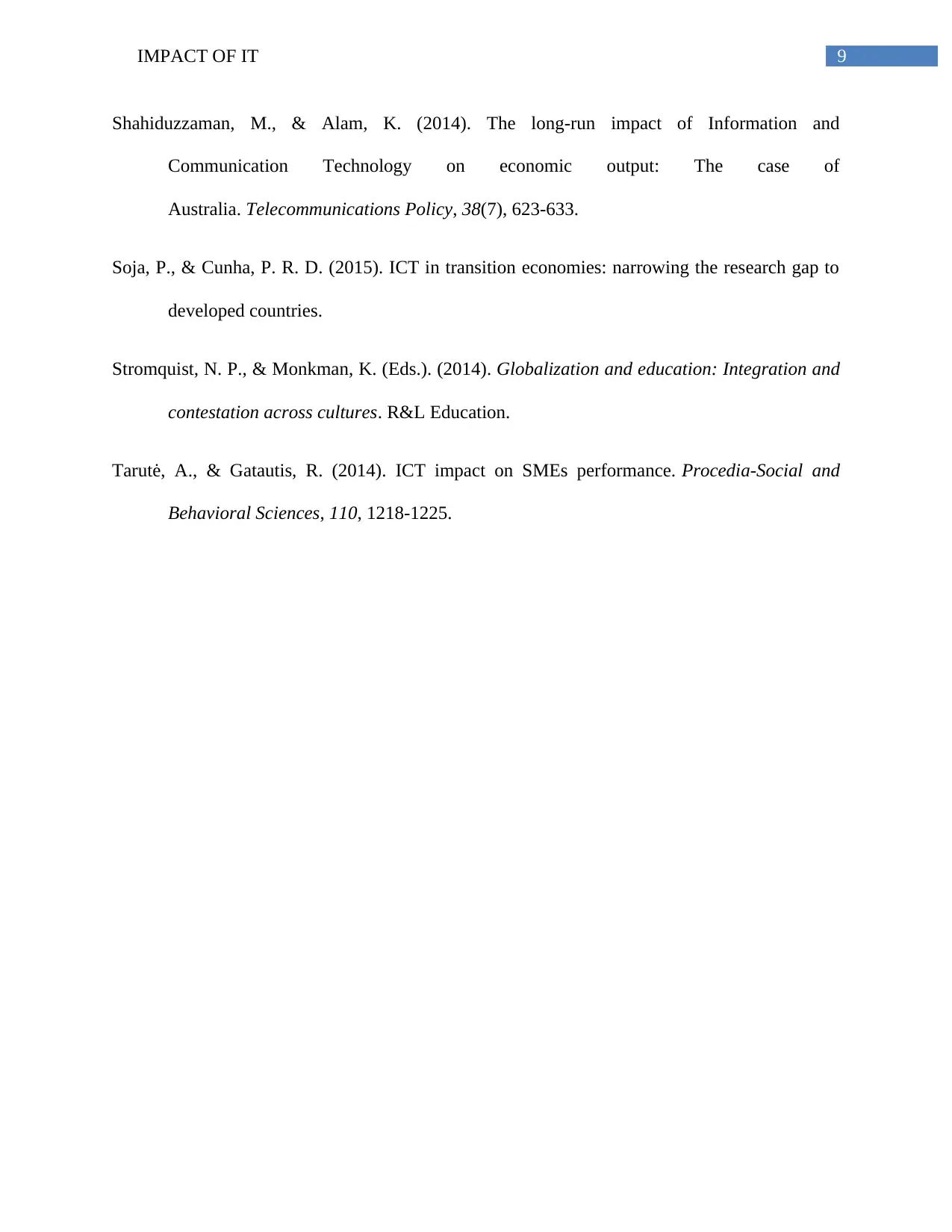
9IMPACT OF IT
Shahiduzzaman, M., & Alam, K. (2014). The long-run impact of Information and
Communication Technology on economic output: The case of
Australia. Telecommunications Policy, 38(7), 623-633.
Soja, P., & Cunha, P. R. D. (2015). ICT in transition economies: narrowing the research gap to
developed countries.
Stromquist, N. P., & Monkman, K. (Eds.). (2014). Globalization and education: Integration and
contestation across cultures. R&L Education.
Tarutė, A., & Gatautis, R. (2014). ICT impact on SMEs performance. Procedia-Social and
Behavioral Sciences, 110, 1218-1225.
Shahiduzzaman, M., & Alam, K. (2014). The long-run impact of Information and
Communication Technology on economic output: The case of
Australia. Telecommunications Policy, 38(7), 623-633.
Soja, P., & Cunha, P. R. D. (2015). ICT in transition economies: narrowing the research gap to
developed countries.
Stromquist, N. P., & Monkman, K. (Eds.). (2014). Globalization and education: Integration and
contestation across cultures. R&L Education.
Tarutė, A., & Gatautis, R. (2014). ICT impact on SMEs performance. Procedia-Social and
Behavioral Sciences, 110, 1218-1225.
1 out of 10
Related Documents
Your All-in-One AI-Powered Toolkit for Academic Success.
+13062052269
info@desklib.com
Available 24*7 on WhatsApp / Email
![[object Object]](/_next/static/media/star-bottom.7253800d.svg)
Unlock your academic potential
Copyright © 2020–2025 A2Z Services. All Rights Reserved. Developed and managed by ZUCOL.




